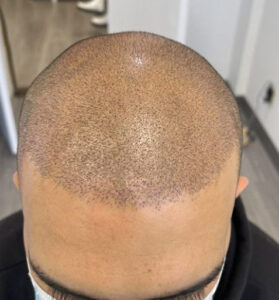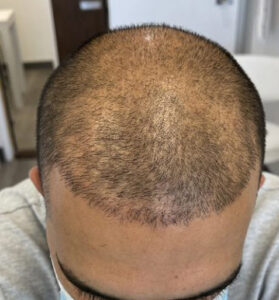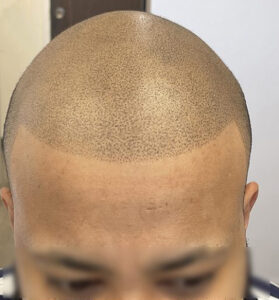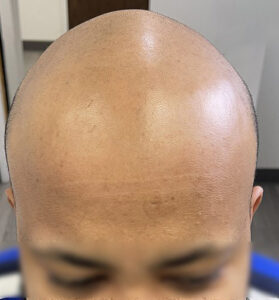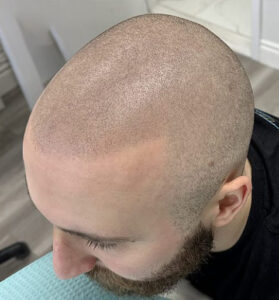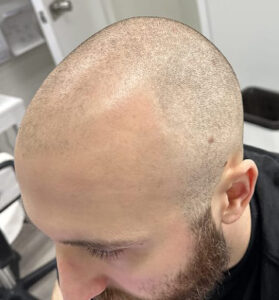Scalp Micropigmentation vs Hair Transplant – Which is Better?
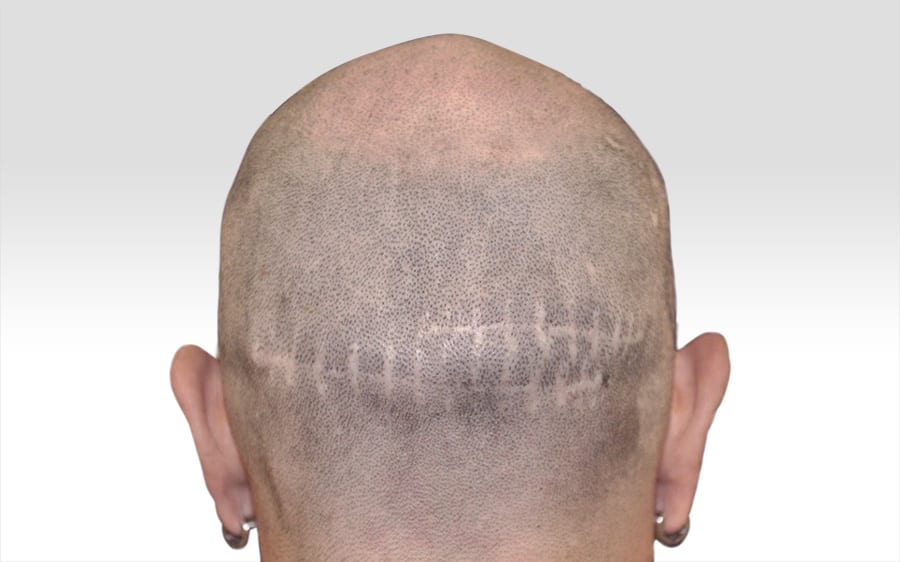
SCALP MICROPIGMENTATION VS HAIR TRANSPLANT – WHICH IS BETTER?
You are losing your hair, and the hair loss treatments you’ve been using, like Minoxidil and Propecia for your scalp just aren’t working anymore. What should you do? There are only two options left, scalp micropigmentation vs hair transplant. Both are very popular, but is one better than the other?
Your decision would be based on three main things:
- Your budget
- Your hairstyle
- The amount of donor’s hair you have (back of scalp area)

There are two main types of hair transplant procedures, FUT and FUE. In FUT (Follicular Unit Transplant/strip), the surgeon removes a strip of donor skin where the individual follicular units are harvested and transplanted to the thinning area. In FUE (Follicular Unit Excision), each follicular unit is harvested directly from the scalp one at a time.
Advantages of Hair Transplant
- It’s permanent. Once you’ve completed two to three transplant sessions, if done by a good hair transplant surgeon, your hair should look completely natural.
The disadvantage of Hair Transplant
- Costly: On average, between $10,000-$15,000, depending on how many sessions you require and the type of hair transplant you choose (FUE or FUT). You can find cheaper surgeons, e.g. in Turkey, but still need to pay for a flight and hotel and go back more than once.
- Invasive: This is a surgical procedure, and there could be complications with any surgery.
- Scarring occurs on the back of your scalp where the donor’s hair was harvested. This may be fine if you wear your hairstyle long; however, if you want short hair or have a buzz-cut look, both types of scarring (strip and pitting) can be seen.
- Down Time: Because it is surgery, you will need to take some time off work for the healing process to take place.
- Hair Shock Loss: It’s a term that happens to your hair after a hair transplant. Shock hair loss usually occurs between two to eight weeks after a hair transplant, when your new hair grafts enter a resting phase and the hairs are shed.
- Multiple Sessions required: Depending on how much hair you’ve lost, you may need anywhere from two to three sessions to complete your hair transplant. In an average hair transplant, between 500 to 2500 grafts are harvested and planted in a single session. However, if more grafts are needed, then at least two sessions are required, spaced six months apart. So, in the interim, you’d need to settle for a half-finished look for months or even longer.
- Not enough donor hair. This is perhaps the most disadvantageous issue with hair transplants. If you don’t have enough donor’s hair, it will lead to poor results. It will look half-finished and not the thicker-looking hair you had hoped for. If you are in the process of losing your hair, the problem is you don’t know exactly how much more your hair is going to recede. Transplanting hair follicles from the back of the scalp that may still recede will eventually miniaturize and fall out in the front.
If you’ve already lost most of your hair and have a good idea no more is going to fall out, then the hair transplant surgeon can assess whether you have enough donor hair to complete a successful hair transplant. If you don’t, SMP scalp micropigmentation is the only alternative unless you want to wear a hair system (toupee or wig).
So, what is SMP? SMP, or Scalp Micropigmentation for short, is applying individual dots of inks into the scalp to replicate hair follicles. If done by a well-trained technician, the results look like natural hair follicles, even at close range.
Advantage of SMP Scalp Micropigmentation
- Affordable: (compared to hair transplant). Cost range on average from $3000-$5000 depending on the area of the scalp that needs to be done.
- Non-Surgical: The needle for SMP is much smaller than traditional tattoo needles. Also, the penetration depth is not as deep as a conventional tattoo—so little or less pain than regular tattoos.
- It can hide scars left from hair transplants. So if you’ve done previous hair transplants, and don’t have enough donor’s hair or want to change your hairstyle to the buzz cut look, SMP can do a great job in hiding scars left over from hair transplants.
- Little or No Down Time: A typical SMP session takes 1-3 hours. Afterwards, you can go about your regular day. Some redness on the scalp is typical but compared to a hair transplant; you don’t need to stay home for many days or weeks.
- It can be done on the scalp with existing hair to make it appear thicker. This is good for women who may experience thinning hair but retain their frontal hairlines.
- SMP Scalp Micropigmentation is a permanent solution to hair loss. A touch-up is usually not required for at least 8-10 years.
- Most SMP clients are pleased with their results. Imagine not having a frontal hairline for many years, and suddenly you have a new look with a hairline and full coverage to your scalp. Your appearance and confidence level will soar.
Disadvantages of SMP
- SMP Scalp Micropigmentation requires you to wear your hair in a semi-shaven buzz-cut look. It may not be for you if you don’t like this look.
- SMP requires two to three sessions. To achieve a 3D look, two or three sessions are needed. Stay away from any SMP clinic claiming they can complete the procedure in just one treatment. The first and second sessions are spaced out about one week apart. A third one (if required) can be done two to four weeks after the second one. The first session lays out a lighter pigmentation and slightly higher hairline. This allows the scalp to heal, to see how much of the pigmentation is absorbed into the scalp. Based on the outcome of the first session, the technician will increase the pigmentation and move the hairline down if the client prefers.
- SMP requires you to wear sunscreen on your scalp. If you are outdoors often, then a good sunscreen is needed to protect your investment from the sun’s damaging UV rays. However, if you don’t go out in the sun constantly, you most likely would not require a touch-up for at least ten to twenty years.
So, which is better? Scalp Micropigmentation vs Hair Transplant? Both are good, and both have their advantages and disadvantages.
Hairtattoo.ca technicians have been trained by internationally recognized Ian Watson of HIS Hair Clinic in the United Kingdom, the originator of the SMP process over 20 years ago. As a result, they are widely regarded as the best in the world.
If you believe you are a good candidate for SMP Scalp Micropigmentation, why not give TRICHOLOGY CENTRE |Hairtattoo.ca | Hairlossclinic.ca a call at 647-492-9093 for a free consultation? We have a consultation clinic downtown Toronto, and our main treatment centre is in Richmond Hill.
Working Hours
- Monday 10:00AM – 8:00PM
- Tuesday 10:00AM – 8:00PM
- Wednesday 10:00AM – 8:00PM
- Thursday 10:00AM – 8:00PM
- Friday 10:00AM – 8:00PM
- Saturday 10:00AM – 8:00PM
- Sunday - Closed
Quick Contacts
- 7549 Kalar Rd, Niagara Falls, L2H 2Y6
- Toronto: 600 Sherbourne St #605, Toronto, M4X 1W4
- Richmond Hill: 8763 Bayview Ave #5, Richmond Hill, L4B 3V1
- Mississauga: 1358 Hurontario St #B2, Mississauga, L5G 3H4
- Winnipeg: 712 St Mary's Rd, Winnipeg, MB R2M 3N1
- INFO@HAIRTATTOO.CA
- (647) 492-5022 Toronto GTA
- (204) 809-5885 Winnipeg
- 2023 HAIRTATTOO.CA | Scalp Micropigmentation & Trichology Centre



